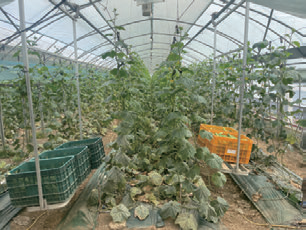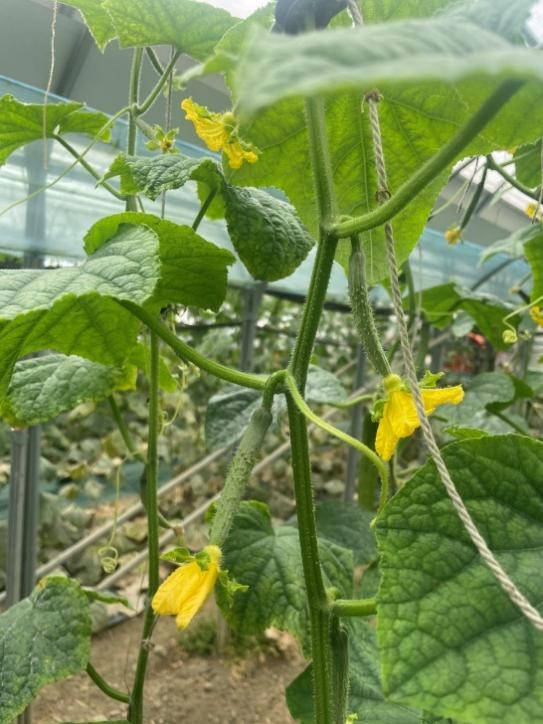Knowledge Hub

Cucumber Cultivation Using Nousbo's Hi-Cote CRF
Cucumber Cultivation Using Nousbo's Hi-Cote CRF
2024-08-21
Cucumber Cultivation in Korea
Cucumbers are widely cultivated across South Korea, with a yield of over 80t per hectare. Despite their fast growth and short cultivation period, cucumbers are highly sensitive to environmental conditions and require advanced cultivation techniques. Being a cold-sensitive crop, cucumbers are prone to frost damage in Korea's variable spring and fall temperatures, leading to predominant greenhouse cultivation. This method, however, demands careful management of soil EC and pH levels due to the risk of soil salinity build-up from excessive fertilizer use.


▲ Two weeks after cucumber planting (left) and greenhouse cultivation facilities (right)
Soil Management for Cucumber Cultivation
Cucumber roots predominantly occupy the top 15-30 cm of soil, necessitating a well-maintained soil environment for optimal growth. They thrive in soils rich in organic matter and good aeration, often achieved through ample compost application. However, using poorly decomposed compost can cause excessive leaf growth or leaf curling, so fertilizer amounts are determined based on soil tests. Cucumbers are also sensitive to high salinity, with growth-inhibiting EC thresholds of 0.6 mS/cm in sandy soils and 1.5 mS/cm in loamy soils. In greenhouse settings, long-term cultivation and repeated cropping can increase soil salinity, leading to potential growth issues.
| Soil Type | Growth Inhibition EC Limit (mS/cm) | Lethal pH Limit (mS/cm) |
|---|---|---|
| Sandy Soil | 0.6 | 2.0 |
| Sandy Loam | 1.2 | 3.5 |
| Clay Loam | 1.5 | 4.3 |
▲ EC and pH Limit Values by Soil Type
Cucumber Cultivation Management and Fertilization
Cucumbers require a balance between vegetative and reproductive growth for sustained productivity. The ideal transplant size is 20-30 days after seeding when 3-5 true leaves have emerged, with shorter seedling periods in summer to prevent root aging. Plant spacing is typically 160-200 cm between rows and 30-50 cm between plants to avoid overcrowding, which can cause light deficiency and fruit abnormalities. Cucumbers also have high oxygen needs and are sensitive to both dryness and excessive moisture.

▲ Deficiency Symptoms on Leaf Margins
When leaf edges show deficiency symptoms, as in the picture above, fertilization is necessary based on soil test recommendations. For cucumber cultivation in Korea, the following guidelines are generally followed:
1. Fertilizer Amount and Timing
- Raw rice straw and poorly decomposed compost: applied 70-100 days before transplanting
- Raw rice straw: 6-10t per hectare at 10 cm intervals
- Lime: applied annually at 60-100 kg
2. Basal Fertilization
To produce 1 ton of cucumbers, an average of 2.8 kg nitrogen, 0.9 kg phosphorus, 3.9 kg potassium, 3.1 kg lime, and 0.7 kg magnesium is needed, though this can vary based on farm conditions.
| Type | Nutrient Type | Basal Dressing | Top Dressing | Total | Application method |
|---|---|---|---|---|---|
| Open field cultivation | N | 11.2 | 12.8 | 25.0 | Nitrogen top-dressing: 4 applications Potassium top-dressing: 2 applications |
| P | 16.4 | 0 | 16.4 | ||
| K | 15.9 | 7.9 | 23.8 | ||
| compost | 2,000 | 0 | 2,000 | ||
| lime | 200 | 0 | 200 | ||
| Controlled environment cultivation (greenhouses) |
N | 9.2 | 19.7 | 19.7 | |
| P | 10.3 | 10.3 | 10.3 | ||
| K | 8.1 | 12.2 | 12.2 | ||
| compost (actual amount) |
2,000 | 2,000 | 2,000 | ||
| lime (actual amount) |
200 | 200 | 200 |
▲ Standard Fertilizer Application Rates for Korean Cucumbers (National Institute of Agricultural Sciences, Republic of Korea, 1996),
Nutrient Amounts in kg/10a
3. Top Dressing
- Timing: When the first female flower starts fruiting (about 30 days after transplanting)
- Application Rates: Winter Season: 2-3 kg of nitrogen and potassium per 0,1ha, applied every 7-10 days at the beginning of harvest, then adjusted based on plant vigor
Summer Open Field Cultivation: Quick-acting fertilizers applied every 5-6 days
4. Soil EC and Nitrogen Content in Greenhouse Cultivation
Managing soil EC is crucial for cucumber cultivation in greenhouses, as it directly affects plant growth and yield.
| Soil EC (mS/cm) | Expected Nitrate Nitrogen Content (kg/0.1ha) | Nitrogen Content Assessment | Recommendation |
|---|---|---|---|
| 0.1 or less | 4 or less | Definitely deficient | Top dressing needed |
| 0.2~0.4 | 1~7 | Deficient to slightly deficient | Top dressing needed |
| 0.5~0.6 | 4~15 | Slightly deficient to adequate | Apply top dressing based on growth status |
| 0.7~0.9 | 6~25</td> | Adequate | No top dressing needed |
| 1.0~1.2 | 11~28</td> | Adequate to slightly excessive | No top dressing needed |
| 1.3~1.5 | 16~40 | Slightly excessive to excessive | May cause excessive growth, water heavily |
| 1.6~2.0 | 20~55 | Excessive | May cause excessive growth, reduce salinity with heavy watering |
| 2.1 or upward | 30 or upward | Definitely excessive | Reduce salinity with repeated heavy watering |
Cucumber Cultivation with Hi-Cote CRF
Hi-Cote is a high-performance fertilizer from Nousbo, designed to release nutrients in sync with the crop's growth cycle, allowing for a single application to sustain the entire season and reduce soil salinity issues. A comparative test between Hi-Cote and conventional fertilization was conducted at a cucumber farm in Anseong. Two connected greenhouses were divided, with one half treated with conventional methods (control) and the other with Hi-Cote.
| Treatment | Area | Basal fertilizer | Additional fertilizer | |
|---|---|---|---|---|
| Hi-Cote | 500m2 | Compost (Chicken manure 200kg/500m2) | Hi-Cote (24-6-12) 15g | No additional liquid fertilizer |
| Control | X | Liquid fertilizer (20-20-20, Herocris) 10kg/ 0.1ha treatment | ||
▲Comparative Test of Hi-Cote Treatment and Conventional Fertilization Methods
The test at the Anseong cucumber farm showed that even after 160 days, the Controlled Release Fertilizer maintained leaf color and plant vigor, indicating the sustained release of nutrients from Hi-Cote.


▲(Difference in Leaf Color: Left (Hi-Cote) vs. Right (Control)


▲Difference Between Hi-Cote (left) and Control (right)
The farm found that Hi-Cote CRF fertilizer outperformed traditional methods by promoting robust early growth and maintaining nutrient release without the need for additional fertilization. They also observed shorter internodes, which led to higher yields. Most notably, the reduced labor required made the process much more convenient and satisfactory.


▲Difference in Cucumber Weight: Left (Hi-Cote : 193g) vs. Right (Control : 186g)
Comparing the samples using a scale, the Hi-Cote cucumbers averaged 193g, while the control cucumbers averaged 186g. This indicates that Hi-Cote cucumbers were either similar in weight or heavier on average, demonstrating higher cultivation effectiveness relative to the labor involved.
Cost-Effective and Equally Effective


1. Features of Hi-Cote:
1. Enhanced Stability: The coating technology ensures that even with a weekly application of 20g, no nutrient loss occurs.
2. Improved Early Growth: Contains over 20% nitrate nitrogen, promoting rapid initial growth and reducing nutrient loss risks.
3. Maximized Fertilizer Efficiency: Applied directly to the root zone to optimize fertilizer utilization.
4. 100% Special Coated Fertilizer: Utilizes advanced proprietary coating technology to coat all nutrients (nitrogen, phosphorus, potassium).
5. Tailored Nutrient Release: Features both Linear and Sigmoid release technologies to match the crop’s growth stage and nutrient needs.


2. Advantages of Hi-Cote CRF
1. Reduced Labor for Fertilization: With just one application at planting, Hi-Cote provides nutrients throughout the entire growth period, eliminating the need for additional fertilization.
2. Reduced Fertilizer Usage: Fertilizer is applied directly to the crop root zone, minimizing use in unplanted interrow spacing and reducing overall fertilizer consumption.
3. Maximized Fertilizer Efficiency: Nutrients are released as needed by the crop, decreasing losses due to volatilization and leaching.
4. Reduced Soil Salinity in Greenhouse Cultivation: Lowering the amount of fertilizer used helps mitigate salinity issues in controlled environments.
5. Minimized Environmental Impact: By reducing fertilizer usage, Hi-Cote significantly decreases greenhouse gas emissions and non-point source pollution in waterways.
Nousbo is listening to your valuable opinions through the customer inquiry page.
If you leave any inquiries, we will answer you with sincerity.

